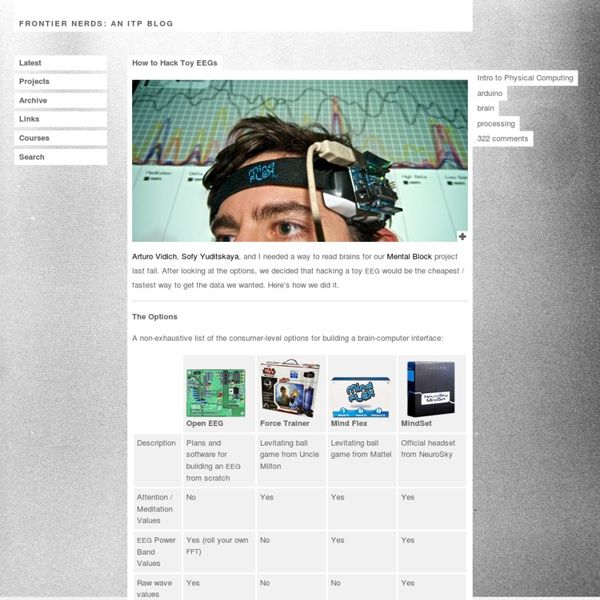Hack Toy EEGs by Mika

EmoRate by AT
Future Applications EmoProfiles The list of potential applications for Affective Computing aka Computing With Emotions is incredible. As the technology develops people will develop EmoProfiles, profiles of their emotional reactions to videos, songs, books, reviews, anything and everything that sparks an emotional reaction (which basically is everything since we are emotional beings). The definition I have come up with for an EmoProfile: “An EmoProfile is a profile that contains data cataloguing your emotional reactions to various stimuli, tagged by keywords and other ontological aids and statistics, in a manner that allows one profile to be compared with another or a group of other profiles digitally by any reasonable computing device.” As adoption of EmoProfiles spreads they will become powerful tools for predicting what someone likes and dislikes, and how compatible people will be with each other and when interacting in a group. Emotion Based Recommendation Systems Emotion Guided Search
MindFlex xbee eeg hack
Heyo guys, this is my last ultimate hack for the mindflex. I wanted to reproduced the results of the mindflex as indicated by the manufacturer.The simplest test that can be done with an EEG device is to check if the alpha waves go up significantly when closing your eyes. However doing some test with different subjects (i.e. my guinea pig students/friends) and with or without electrogel I couldn’t find any prove that the neurosky chip is working properly. So you take out of the shell 3 wires: black is the GND, blue is the Vcc=3.3V and white is the TTL signal at 9600 bauds. stream directly to the computer and one which uses a xbee transmitter and an xbee receiver. As I said before I totally desoldered the original radio modem that was on the main board inside, as in Figure. What can I do with that? Serial configuration The first configuration is the most dangerous one since you are connected to your computer via the usb without any opto-isolation so DO IT AT YOUR OWN RISK. XBee configuration
GlovePIE
BioSig
Processing-Brain-Grapher
neuro.debian
BioEra
Processing EPOC via OSC by Madara
Related articles: AffectCircles How would you like to create interactive art that responds to your thoughts, moods, and facial expressions? Thanks to Mind Your OSCs and oscP5, interpreting the Emotiv EPOC‘s data within a Processing sketch (and by extension, Arduino) could not be easier, even with the consumer (i.e. most affordable) version of the EPOC. Here is how it works. To begin, you need an Emotiv EPOC and the Mind Your OSCs application which you can download for free from the Emotiv store. In the right-hand side of the Mind Your OSCs window, you can see the IP address and port number for data going out of Mind Your OSCs (connection info for data coming into Mind Your OSCs from the EPOC device or an emulator, etc., is displayed on the left-hand side of the window): In Processing’s setup() method, you set up a connection to the same port showing in Mind Your OSCs: Each OSC message sent from Mind Your OSCs has three parts:
Related:
Related:



